Last column, we began a look into the small textual material box belonging to Cy Bell in the Bell Features fonds at the Library and Archives of Canada in Ottawa. We began that look with a hundred-page or so ledger-type book into which were pasted torn back cover contest sheets from late 40’s and early 50’s Bell reprint comics.
In this column, I want to make a second foray into that box and see some of the other things found in it.
The next thing I encountered in the pile of documents taken from the box was a contract between Bell Features and its Art Director and chief cover artist, Adrian Dingle. This is one of two contracts that found in the box. The second is a similar contract for Howard B. Cowan (whose pseudonym was Clayton Dexter), however, the difference is that the contract with Dingle was completed and signed, while the contract for Cowan was not.
Here is the contract made with Dingle:
The contract is dated February 22 1946 and, like most of the documents in the box, is from the post-war period (1945-47), late in the existence of Bell Features as a publisher of original material Canadian comics. The handwriting that fills the open portions of the contract is Cy Bell’s because we can compare it with some of the signed, handwritten letters that also come out of the box. The slightly calligraphic style looks to have been done in fountain pen (Do younger collectors even know what one of these things is?) which, judging from other samples of handwriting in the box, seems to have been Cy Bell’s preferred writing instrument. I can visualize his small, gaunt form rushing around the Bell Features offices with a couple of these, perhaps gold-plated, in his inside jacket pocket ready to be whipped out, unscrewed and put to work scratching out impromptu notes or messages.
We can see, at the time, that Dingle lived in Port Credit and that the property Cy Bell was negotiating for was Nelvana. After looking through all the material in the textual container, we get the clear impression that Cy Bell was girding up his company for survival through the post-war storm of American comic glitz that had made landfall on the Canadian cultural coastline. The mini-skirted Inuit demi-goddess looked to be a key part of this.
Now, I can’t pretend to understand all the legalese in the contract, but what is clear is that Bell Features clamped down on the ownership and copyright of Dingle’s character, Nelvana, apparently removing Dingle, himself, from any ownership. I don’t know where copyright on the Bell Features characters stands currently, but in 1971, Patrick Loubert and Michael Hirsh purchased what was left of the holdings from publisher John Ezrin (father of legendary music producer, Bob Ezrin) and immediately sold most of it to the national archives in Ottawa to obtain seed monies for their new animation company Nelvana Studios. Though I haven’t seen any legal documentation to support this (if any exists), Loubert and Hirsh sold, along with the physical comics and artwork, half the copyright to this material while retaining half of it with their company Nelvana Studios. I base this on the fact that when I published Heroes of the Home Front, I had to seek permission to reproduce images of any Bell Features comic book covers and of any of the original artwork both from the Library and Archives of Canada and from Corus Entertainment which now owns Nelvana Studios. I did ask Corus to show me documented support for their claim to half the copyright, but never got a response.
In any event, current Canadian copyright law (see the useful FAQ here) indicates that intellectual properties become public domain 50 years after the death of the creator (which in Dingle’s case would occur at the end of 2024 except for the fact that the new Canada-US-Mexico Agreement would extend this to the 75 years waiting period in effect in the US). However, I’m not sure how the above-signed transfer of copyright to Bell Features impacts this.
Next comes a pair of blank, typed-out-Bell-letterhead applications to trademark the Bell logo.


According to BC artist Alfred Muma, it was Oscar Schlienger who originally designed this logo (see my chapter on Schlienger in Heroes of the Home Front). The letterhead gives the phone number for the Bell offices as “WAVERLY 6600” and you have to be a bit of an oldster to understand what this means. Phone numbers at this time in Toronto involved six pulls on the rotary dial. The first two pulls were the first two letters of the exchange area name, which in this case would be “WA” and these correspond to the numbers “9” and “2” on the rotary dial (see pic below). This was intended as a mnemonic of sorts to help you remember numbers more easily.
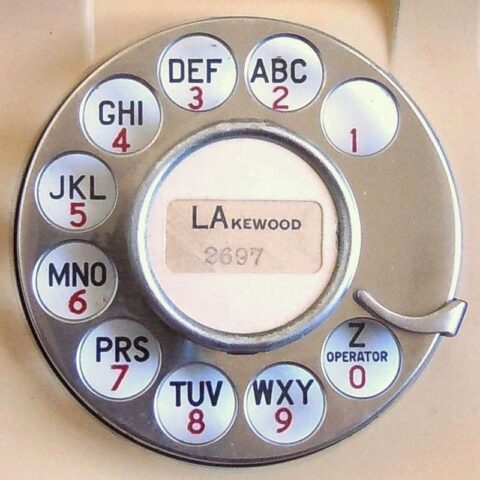
Both these are trademark letters are undated, one addressing the Commissioner of Patents, which is a Canadian office, and one addressing the United States Consulate in Toronto. I presume these, like most of the textual material in this box, to be from 1945-46 and their existence seems to indicate that Bell was looking to expand into the American market post-war. Bell wanted to establish their well-known bell logo as trademarked in both countries.
Here are a couple of examples of the Bell logo as it evolved:


Next up is a legal-sized notice addressed to Bell Features from the Trade Marks Office of the Dept. of the Secretary of State, Canada dated June 6, 1946. It is the negative response to a request by Bell Features to trademark the name “Johnny Canuck” on the apparent contradictory grounds that the phrase could be the name of a person and that there might be an infringement of the property “Jack Canuck” which had been registered six months earlier. I wonder if Bell appealed this ruling or dropped the process altogether?
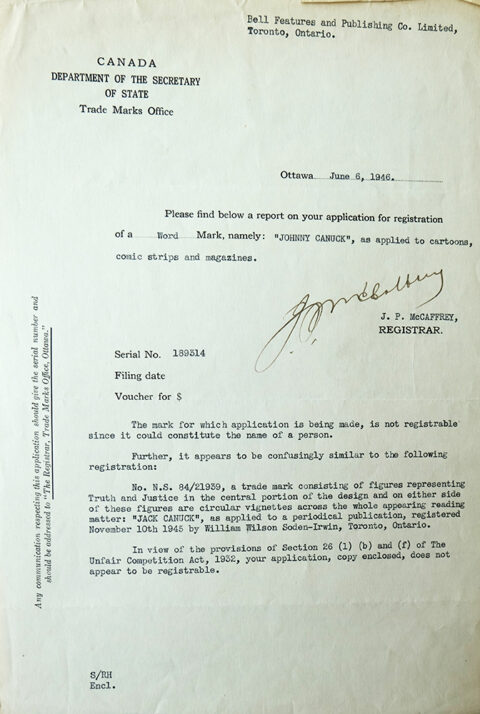
The last thing from the Bell text box that I want to cover for this column is a set of 58 copyright certificates dating from 1942-47. I’ve organized the info from them into a table at the end of this column, but I want to look at a few individually.
The earliest are a set of four that cover the copyrights for Active, Dime, Joke, and Commando Comics.
What we can learn from these copyright certificates are the actual dates that the books hit the newsstands since the date of first publication is given. The first issues of Active and Dime Comics were on the stands Feb. 1, 1942, while Joke Comics No. 1 was available from March 15 1942 and Commando Comics No. 1 from October 17 of the same year. The certificates also credit the creators involved in each issue so that we learn a little more about a couple of the more mysterious creator names given in the comics themselves.
For example, the creator of Ace Bradley in Commando 1 is given on the splash appearing in the comic as “E.B.C.” This must be the Barnard [Bernard?] Clarke credited on the copyright certificate and that he lived in Toronto.
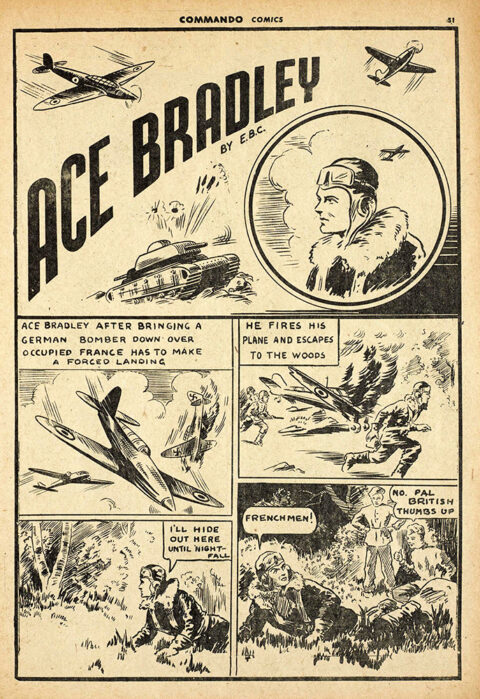
From the Joke Comics copyright document, we learn that Josh Silburt was the contributor of one-panel cartoons to the issue which he signed “Burt.” Here is an example of one:
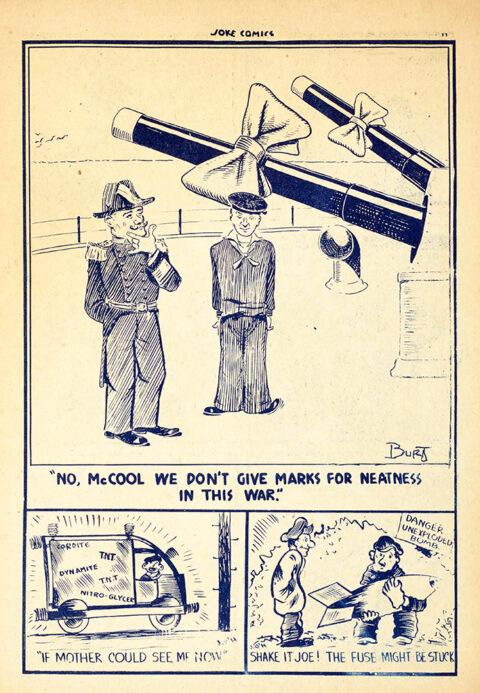
We also learn that Frank Mann Harris, who created and wrote the “Three T’s” feature and the text story in Joke 1 must have been a pen name for E. R. Harris. Frank Mann Harris also wrote short stories for McLean’s Magazine in the mid-1930s and here is an example.
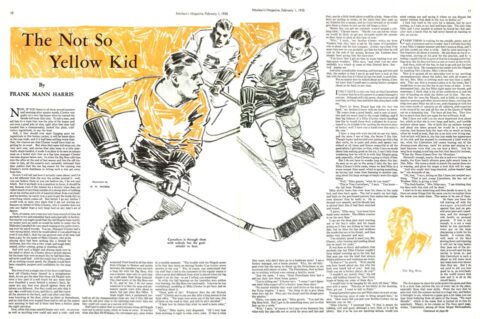
Josh Silburt was a well-known political and sports cartoonist of the time and also a good friend of Avrom Yanovsky, who later also worked for Bell Features. The two were fellow Canadian communists who eventually also worked as fine artists.
The copyright sheets for the characters Johnny Canuck and The Brain are notable for the fact that, though copyright was originally obtained for both characters in 1942 on behalf of Leo H. Bachle, there is a handwritten note from Leo in the top left of each document dated Dec. 29 1944 that transfers this copyright to Cy Bell. It’s fun to speculate why Leo Bachle would have done this, but it was around the time he left Canada and Bell Features to try his luck in the U.S.
There are also half-a-dozen copyright sheets dated in late 1945 that are for titles such as Jet-Man, Red Hot, Unusual, Slam-Bang, F.B.I., and Terrific Comics which we know from indicia came out first in 1946 or later but their stated dates of first publication are all before 1945 runs out. A possible explanation or this might be that these 1945 dates were the dates that ashcans were produced to cement the copyright and that the newsstand versions of these appeared later. For example, we know that ashcans were produced for Jet-Man, Red Hot, and F.B.I. Comics, but were ashcans produced for the rest of those titles as well?



I also need to draw attention to the copyright sheets for the characters Rex Rainer, The White Mask, and Mr. Monster, all claiming to have been obtained and also first published early in 1946. Mr. Monster does appear in the last panel of the Doc Stearne story in the last issue of Triumph Comics, but a full story featuring Mr. Monster didn’t appear until Super Duper Comics in early 1947. The White Mask is the superhero counterpart of Ted Steele’s Speed Savage and maybe Cy Bell was going to give him his own title, but as far as I know, that was never officially published unless as an ashcan though a compendium of Speed Savage came out in the summer of 1945. As for Rex Rainer, we do know of the existence of a half-dozen original art pages, but no splash, for a Rex Rainer story that was drawn by Clayton Dexter around this time, but there is no record of it ever being published. From the pages that exist, it looks like Rainer would have been a sort of Flash Gordon trope adventuring in a civilization who dressed like ancient Romans but possessed advanced technology.
The last oddity I want to mention is the copyright sheet for Super Duper Comics which is states that it is held by Cy Bell and Bell Features and that it was first on the stands March 31, 1947. The March date could correspond with the indicia for Super Duper Comics No. 3 since comics do tend to appear on stands a month or two before indicia dates, however, the book with that title appearing at that time was published by F. E. Howard publications and also distributed in the US. The mechanics of all this is still unclear.
Some of the other copyright sheets may raise other questions, but let me list those copyright sheets in the following table so that you can survey them:
| Date Copyright Applied for | Date of First Publication | Likely Place of First Publication | Property Applied for | Applied for on Behalf of |
| March 17, 1942 | Feb 1 1942 | Dime Comics 1 | Dime Comics | Commercial Signs of Canada |
| March 25, 1942 | Feb 1 1942 | Active Comics 1 | Active Comics | Commercial Signs of Canada |
| April 9, 1942 | Mar 15 1942 | Joke Comics 1 | Joke Comics | Commercial Signs of Canada |
| August 7, 1942 | Feb 1 1942 | Dime Comics 1 | Johnny Canuck | Leo H. Bachle transferred to CVB 1944 |
| August 7, 1942 | Feb 1 1942 | Active Comics 1 | The Brain | Leo H. Bachle transferred to CVB 1944 |
| January 16, 1943 | Oct 17 1942 | Commando Comics 1 | Commando Comics | Commercial Signs of Canada |
| January 12, 1945 | Oct 27 1945 | Dime Comics 26 | Hugh Dunnit | Avrom Yanovsky |
| January 12, 1945 | Sep 25 1944 | Dime Comics 25 | The Polka Dot Pirate | Allan Ross Mendes |
| October 27, 1945 | Aug 17 1945 | Ashcan? | Giant | Cyril V. Bell (CVB) |
| October 27, 1945 | Sept 14 1945 | Ashcan? | Jumbo | CVB |
| October 27, 1945 | April 11 1945 | Ashcan? | Colossal | CVB |
| December 4, 1945 | June 20 1941 | Triumph-Adventure 1 | Tang | CVB |
| December 4, 1945 | March 1 1942 | Wow Comics 7 | Jeff Waring | CVB |
| December 4, 1945 | Feb 1 1942 | Dime Comics 1 | Rex Baxter | CVB |
| December 4, 1945 | March 15 1942 | Joke Comics 4 | The Wing | CVB |
| December 4, 1945 | Feb 1 1942 | Active Comics 1 | Active Jim | CVB |
| December 4, 1945 | Feb 1 1942 | Active Comics 1 | Dixon of the Mounties | CVB |
| December 4, 1945 | March 1 1943 | Wow Comics 16 | Phantom Rider | CVB |
| December 4, 1945 | Aug 1 1944 | Active Comics 18 | Dr. Blue and Blackie | CVB |
| December 4, 1945 | Feb 1 1945(2?) | Active Comics 1? | Thunderfist | CVB |
| December 6, 1945 | Nov 19 1945 | Ashcan | Jet-Man | CVB |
| December 6, 1945 | Nov 19 1945 | Ashcan | F.B.I. | CVB |
| December 6, 1945 | Nov 19 1945 | Ashcan? | Terrific | CVB |
| December 12, 1945 | Nov 27 1945 | Ashcan | Red Hot Comics | CVB |
| December 12, 1945 | Nov 27 1945 | Ashcan? | Slam Bang Comics | CVB |
| December 24, 1945 | Dec 18 1945 | Ashcan? | Unusual Comics | CVB |
| December 24, 1945 | Apr 23 1945 | Triumph Comics 26 | Nels Grant | CVB |
| January 8, 1946 | Jan 1 1945 | Wow Comics 25 | Clip Curtis | F. G. Kelly |
| January 8, 1946 | Apr 1 1945 | Wow Comics 26 | Doc Stearne | F. G. Kelly |
| January 8, 1946 | Feb 1 1945 | Joke Comics 21 | Steve Storms | F. G. Kelly |
| January 8, 1946 | Jan 15 1945 | Active Comics 22 | Betty Burd | F. G. Kelly |
| January 8, 1946 | Apr 15 1945 | Active Comics 22 | Cinder Smith | F. G. Kelly |
| January 12, 1946 | May 1 1942 | Active Comics 4 | The Noodle | Ross K. Saakel |
| January 12, 1946 | May 27 1942 | Wow Comics 7 | Captain Wonder | Ross K. Saakel |
| January 15, 1946 | Dec 1 1943 | Dime Comics 14 | Nitro | Gerald J. Lazare |
| January 15, 1946 | Jan 1 1943 | Dime Comics 15 | Drummy Young | Gerald J. Lazare |
| January 15, 1946 | Nov 27 1945 | Wow Comics 24 | The Dreamer | Gerald J. Lazare |
| January 25, 1946 | June 4 1945 | Super Duper 3 | Java Bean | Harry B. Moyer |
| January 25, 1946 | June 4 1945 | ? | Happy Daze | Harry B. Moyer |
| January 25, 1946 | June 4 1945 | ? | Dibs ‘n’ Dabs | Harry B. Moyer |
| January 25, 1946 | June 4 1945 | ? | Nothing but the Truth | Harry B. Moyer |
| January 25, 1946 | Jan 5 1945 | ? | Animal Tails | Edward Alton |
| January 25, 1946 | Aug 14 1945 | ? | Salty Lane | Howard B. Cowan |
| January 25, 1946 | Oct 4 1945 | ? | The Scarlet Mark | Howard B. Cowan |
| January 25, 1946 | June 4 1945 | ? | Issy[sic] Bright | Harry B. Moyer |
| January 25, 1946 | Jan 15 1946 | ? | Rub n’ Dub | Kenneth Ross Saakel |
| January 25, 1946 | Jan 15 1946 | ? | Rex Rainer | CVB |
| January 25, 1946 | Jan 20 1946 | ? | The White Mask | Theorore [sic] A. Steele |
| January 25, 1946 | Jan 15 1946 | Slam Bang Comics 7 | Zip and Zoom | Edward Alton |
| February 25, 1946 | Jan 15 1946 | Triumph Comics 31 | Mr. Monster | F. G. Kelly |
| February 26, 1946 | Mar 1 1943 | Wow Comics 17 | Guy Powers | CVB |
| February 26, 1946 | Nov 1 1944 | Joke Comics 18 | The Blade | F. G. Kelly |
| February 26, 1946 | July 16 1945 | ? | Young’s Whittlecraft | Robt. Patterson Young |
| February 26, 1946 | Jan 15 1946 | Slam Bang Comics 7 | The Blue Raven | Adrian D. Dingle |
| August 26, 1946 | Aug 14 1946 | Comic Crimes Comics nn | Comic Crimes | CVB |
| August 26, 1946 | Aug 14 1946 | Smasher Comics nn | Smasher Comics | CVB |
| April 12, 1947 | Mar 31 1947 | Super Duper Comics 3 | Super Duper Comics | CVB |
| September 22, 1947 | Aug 26 1947 | ? | Circus of Fun Comics | A. N. Nugent |
NEWS
Rachel Richey’s book on Fred Kelly/Mr. Monster is in the final stages of being readied for publication by RAID Studio and there should be more news about it next month.
Besides the reprint of the first issue of Better Comics for the 80th Anniversary of the first Canadian comic book next year, other ideas that are seriously being worked on include joint Academic/Creator Conference focussing just on Canadian comics and graphic novels for October of next year. Perhaps the most exciting would be an anthology whose main content would comprise one-page cartoon bios of Canadian comic creators/cartoonists from the Platinum era to the modern era along the lines of the one below on Harry Brunt done by David Collier.
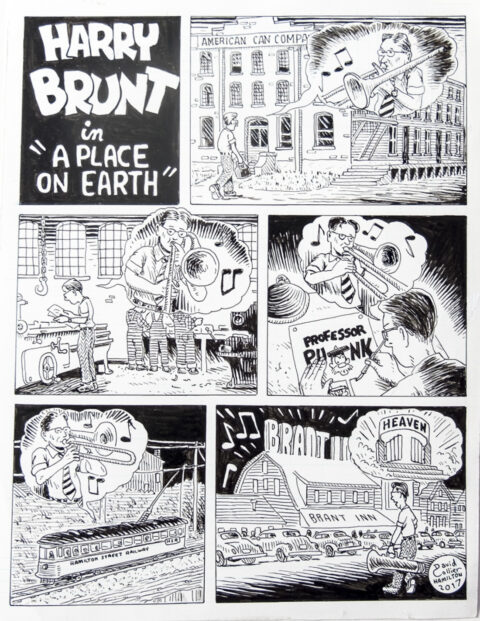
The idea is to commission a different Canadian artist for each one with a total of 80-100 or so of these. It’s easy to come up with more than 100 names ranging from Palmer Cox, Hal Foster, Joe Shuster, Adrian Dingle (and all the other Canadian wartime artists), to Win Mortimer, Jack Sparling, Dave Sim, Seth, Chester Brown, Todd McFarlane, but the hard part is making sure we have proper Quebecois, Gender, Orientation, and First Nations representation and then culling the list down to best reflect the evolution of Canadian cartoon and comics culture. I welcome any suggestions or comments from readers.

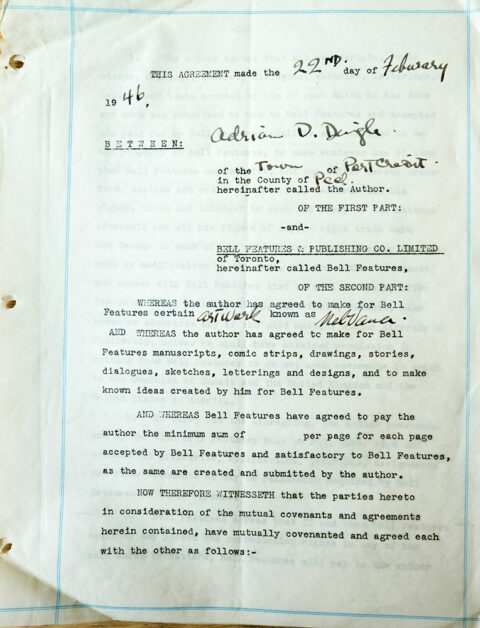
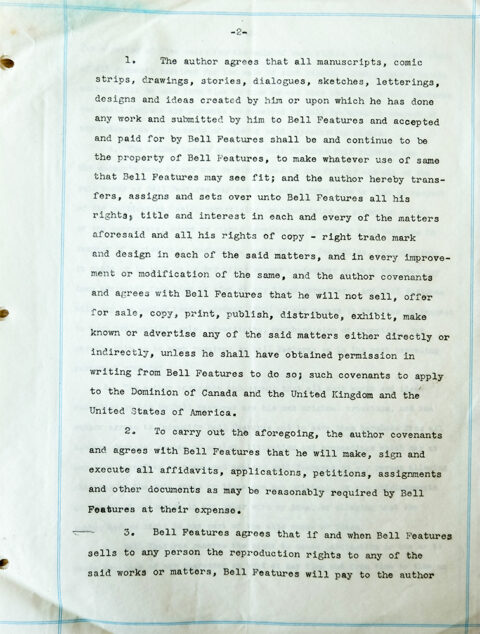
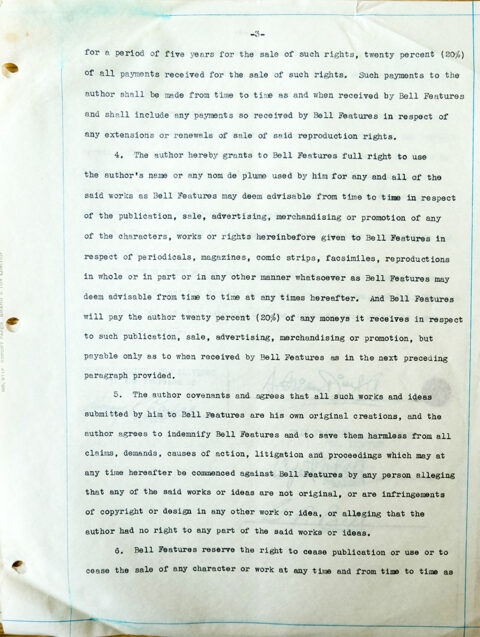
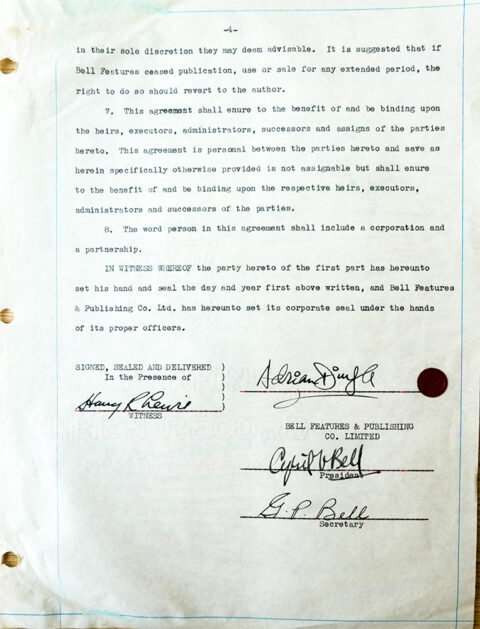
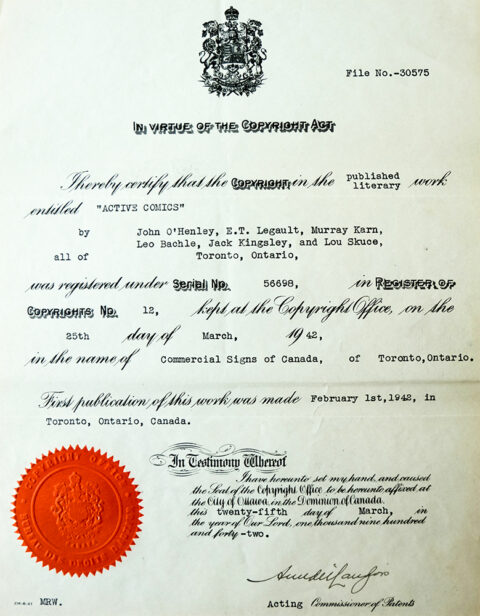
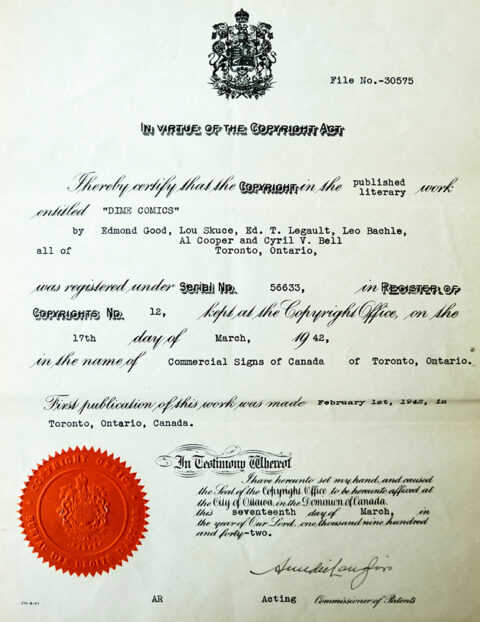
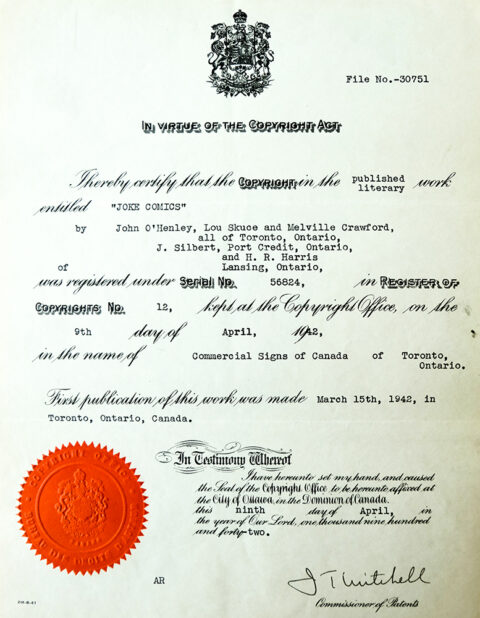
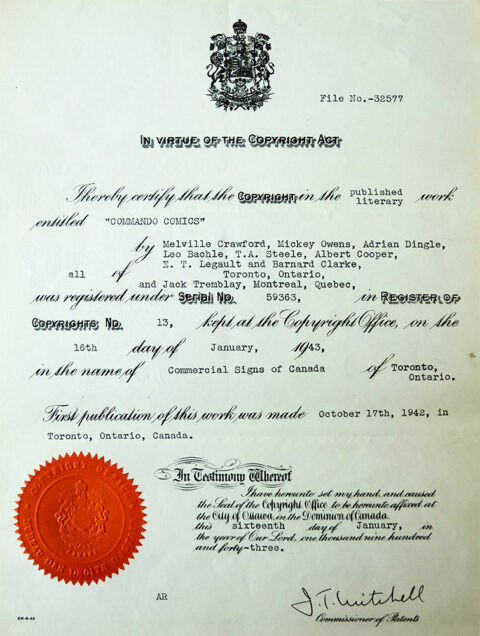
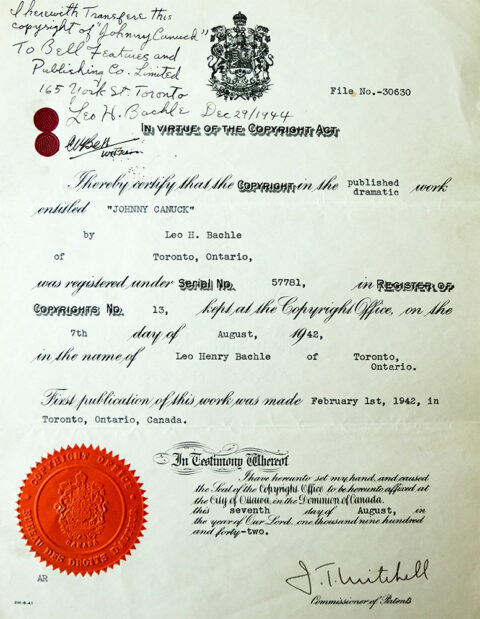
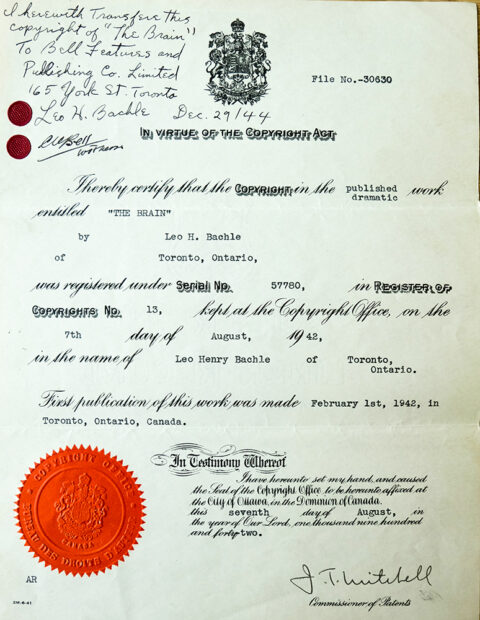
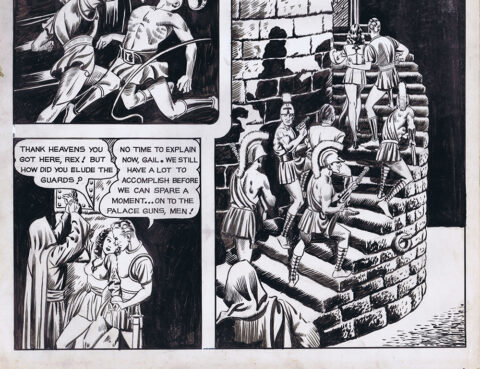
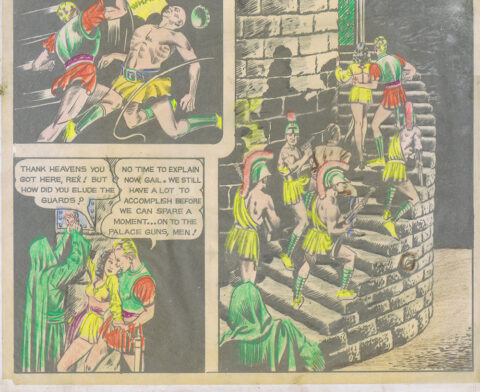
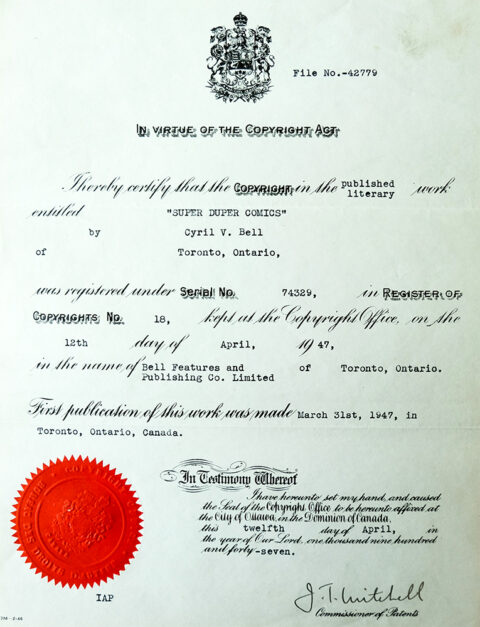
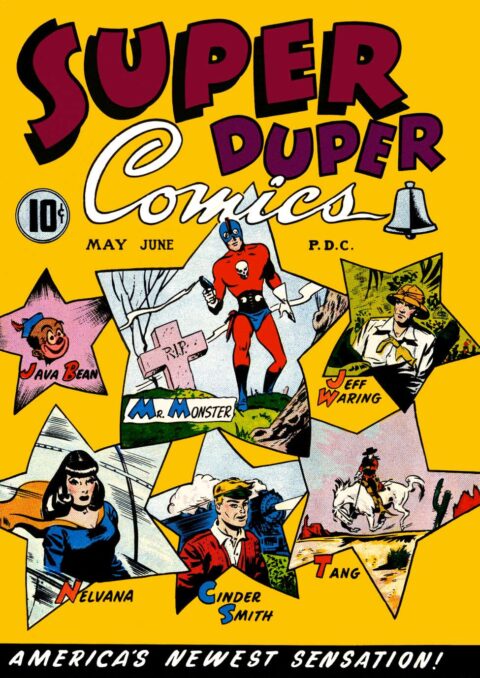



Thanks, as always. Interesting column.
WRT Jumbo comics there was a Jumbo comics with a cover drawn by Manny Easson.
There was also a Jumbo comics issue in 1948 with Pioneer Publications stories inside by B & G Publications with an unsigned cover.
I think the G in B & G is Edmond Good, the cover is his and Pioneer has a relationship with him.
Was there any other contracts or copyright information regarding Bell and Edmond Good?
Thanks for doing all this research, Ivan. Interesting that the page rate isn’t stipulated on the contract between Dingle and Bell.
Jim, that does look like a Manny Easson cover on the Bell Giant Jumbo put out by Bell during the reprint period, but I’m not so sure that the B & G Jumbo that came out in 1948 is by Edmond Good. Are there initials somewhere or is he actually credited. I know that at that time he was in the US and working there and had been for 3 or 4 years. There is nothing else to do with Good in the box probably because he had left Bell to work in the States in 1943. Anybody interested in looking at those covers can find them on the Grand Comics Database (www.comics.org).
Nicholas, I do know that Gerry Lazare was paid about $6 a page and that Jack Tremblay started off at about $3 a page (maybe the fact that he sent his stuff remotely from Montreal and was only 15 at the time he started allowed them to take more advantage of him).
As always Ivan a great column on the history of Canadian comics! When I wonder does it all go into a book? I would gladly contribute to a Go Fund Me if you ever decide to do it! Your research and dedication should be applauded!
Gerald, I do have a 300+ page book out on Bell Features creators called Heroes of the Home Front and I’m down to less than 40 copies left out of a print run of 450. I always list a couple of copies up on eBay if anyone is interested.
Comic Detective on the job, again! Brilliant finds, Ivan, of the historical supplementary material. Thank you again and for the titbit (tidbit?) about the “lost” Mr. Monster book moving forward.
I debate buying another copy of your grand book. Gerald Eddy, it’s WELL worth it!
I’m in “comic happy mode” as I managed to acquire my 2nd – SECOND – just affordable Canadian Golden Age Comic two weeks ago! A very nice copy of FREELANCE #33 from a generous Canadian seller.
That Freelance 33 is the iconic Freelance cover and a good one to get. I wish you luck in obtaining more Canadian golden age books, Tim. If you were commissioned to do a one-page bio or page related to a Canadian creator, whom would you choose?
Thanks, Ivan. Off topic, I know but it was a total surprise find. Every so often I just type in Canadian Comics and scroll through whatever comes up. The same seller currently has a copy of Jet Man #2 up, and others, prices seem “guide-ish”. It was fun to obtain one that I thought I’d never get.
I’m not quite sure what you mean, art for a bio writeup by you?, but send me more details or leave a message on the GoldenAge Boys board. I’ve just joined up there and left a message. I’d have to think who to choose, who do you have? what are you looking for? but I’d say i’m intrigued. Adrian Dingle pops to mind just cause I know a little of his art gallery rep. It might take me a couple of attempts, my former drawing skills are might off (shaky hands, focusing).
Cheers!